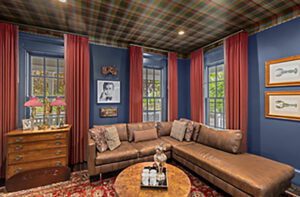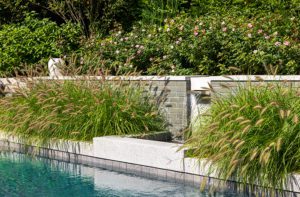Arnie and Barry Johnson of Osterville’s H.F. Johnson Tree Farm
June 4, 2013
If you’re on the Cape or islands and need a big tree, chances are you’ll get it from Arnold (Arnie) and Barry Johnson at Osterville’s H.F. Johnson Tree Farm—just as your parents and grandparents did from their parents and grandparents.
Text by Kyle Hoepner Photography by Keller + Keller
Kyle Hoepner: Arnie, I know your business has been a fixture on the Cape and islands scene since your grandfather founded it in 1920. How have various members of the family been involved over the years?
Arnie Johnson: My grandfather John Johnson, who had just emigrated from Sweden where his family had cared for parks and gardens in the coastal city of Halmstad, started the business in Centerville. After returning from World War II my father, Harry Johnson, went to work for my grandfather. John retired in 1955 and my father ran the business until 1987, when he, too, retired. I started working part-time in high school and full-time in 1975. My son Barry started full-time in 2000, his brother Carl in 2006 and brother Ben in 2008.
KH: The company began as a traditional landscaping service—so how did your current specialty evolve?
AJ: In the early years, shipping plants was more difficult and land was inexpensive, so most landscapers maintained a nursery for their business. I was always most interested in the nursery side of the business, so when my father retired I focused on that.
KH: How big a region do you serve? Does it extend outside of New England?
Barry Johnson: In recent years we’ve delivered trees as far south as Washington, D.C., and as far north as Bar Harbor, Maine. We service all of New England, but the bulk of our work is in southeastern New England.
KH: How are you different from a typical nursery?
AJ: In the size of our trees and shrubs. We start where the garden centers leave off in terms of size. And we have the machinery required to handle the larger trees.
BJ: The majority of our plant stock is planted in-ground in a park-like setting. We find this allows customers to get a more accurate representation of the tree or shrub and how it will fit in their landscape. Unlike many other nurseries we also offer a planting service for all our stock.
KH: What kind of inventory do you keep?
AJ: We have approximately 2,500 plants on around nineteen acres—large evergreen and deciduous trees and shrubs for landscaping.
KH: Do you grow most of your stock at your locations? Or do you order trees and shrubs from other sources?
BJ: We grow about a third of what we sell. We collect another third locally, from homes that are being remodeled or demolished, and we also buy trees that have outgrown a yard or that were planted in the wrong place years ago. The remaining stock we buy from other growers.
KH: Are there special challenges involved in growing your own stock?
BJ: The biggest challenge is guessing what will sell in five to twenty years! We’re still digging trees planted more than twenty-five years ago by my grandfather. Aside from that, the trees require constant care: watering, pruning, fertilizing, spraying.
KH: What’s the biggest tree you’ve ever moved or installed?
AJ: I can remember four or five very large trees we have moved, but I’m not sure which one was biggest. The boys take pictures; I rarely did.
BJ: The largest tree I’ve installed was a fifty-five-foot pin oak; it was planted on a golf course to shield a neighboring house from golf balls. And we’ve transplanted several trees with trunks twenty to twenty-five inches in diameter and heights over sixty feet.
KH: Have there been any unusual requests over the years?
BJ: The most interesting request I’ve received was to locate and plant mahogany trees on a small island in the U. S. Virgin Islands. The logistics of getting equipment there made it next to impossible.
AJ: And once we planted twenty-some European hornbeam trees in stainless-steel planters and craned them onto a rooftop in Boston!
KH: What about interest in local plant varieties versus exotics?
BJ: There is definitely increasing interest in natives in towns along the coast. Many customers want plants that blend into their natural surroundings.
AJ: I think horticultural interest is expanding in all areas. I see more companies specializing in native plants as well as the rare and unusual plants. New hybrids and cultivars are always appearing and being studied for their merit in the landscape.
KH: How involved are you in landscape design?
AJ: Not at all. Our advice is about the characteristics of trees and their suitability for certain sites and exposures.
BJ: We recommend that potential customers hire a landscape architect or other reputable designer for large landscape projects.
KH: What are the uses people make of the trees and shrubs you provide?
BJ: We install quite a few evergreens for privacy screening: we can install a “living fence” up to forty feet tall in a matter of days. We install broadleaf trees for shade in the summer and specimen trees to give scale to or soften the look of a new home. We also sell native trees and shrubs for re-vegetating wetland areas.
AJ: A few people also want fruit trees or shrubs.
KH: Any tips for Cape Cod, Martha’s Vineyard or Nantucket residents looking to add mature trees to their property as opposed to planting them small?
BJ: There are some instances where we will recommend smaller trees. Sites that are exposed to extreme amounts of wind and salt spray are a challenge even for young trees, let alone a mature tree. Look around at the native trees in the area: if they’re only twenty-five feet tall and windswept, it’s a bad idea to install anything larger than that.
AJ: But when you have a large home or want to give your yard an established look, bigger trees make a noticeable difference.
KH: There’s undoubtedly a lot of special equipment involved in your work…
BJ: Our five tree spades are the most unique equipment we own. Together they give us the ability to properly dig trees in a wide range of sizes.
KH: How many other companies in New England are in the same business?
BJ: There are probably some ten to fifteen companies that transplant trees on a regular basis. But very few focus specifically on transplanting and installing mature trees.
KH: Arnie, I gather you now live on the property in Centerville where the business started. What prompted the company’s move to Osterville in 1961? And how have things changed since then?
AJ: My grandfather bought our twenty acres in Centerville at auction for $75—and he complained he paid too much! When he retired he subdivided the nursery into house lots. So my father then bought the Osterville farm as place for his business. I rented the land from him when I took over; it was mostly still field then. By 2001 Osterville was full of trees, and I was able to buy land in Marstons Mills to expand. This was followed in 2010 by our Sandwich farm—it’s the old Roberti dairy farm, which we lease from the town. We started planting there in the spring of 2011.
KH: Do you do different things at each of your three locations?
BJ: The Osterville farm is our main location. Our office and shop are there, as well as most of our equipment. We also have larger in-ground trees and balled-and-burlapped plant material. The Sandwich farm is primarily a growing site. Most of the stock there was planted over the last few years and will not be harvested for another three years. The Marstons Mills farm is where we grow most of our mature rhododendrons—as with the other farms, there is an area there for one-of-a-kind specimens we’ve collected from old estates.
AJ: Each location has its own unique soil characteristics for growing. Osterville is sandy loam; Marstons Mills is light clay; Sandwich is deep loam with a lot of stone and a sandy subsoil. This lets us plant a tree where it will flourish best.
KH: Four generations of the family have been involved in H.F. Johnson Tree Farm. Is there a fifth generation coming along?
AJ: I have seven grandchildren. The oldest is Oscar, who is five. All of the others are granddaughters—some of whom play with trucks, so the potential is there!
BJ: Time will tell. They’re preoccupied playing dress-up and baseball right now…
KH: What do you love most about your work?
BJ: By far, working with my dad and brothers.
AJ: Working with friends and family and working outside. To see the clouds marching across the sky and the trees lifting their arms toward heaven. •
Share
![NEH-Logo_Black[1] NEH-Logo_Black[1]](https://b2915716.smushcdn.com/2915716/wp-content/uploads/2022/08/NEH-Logo_Black1-300x162.jpg?lossy=1&strip=1&webp=1)








You must be logged in to post a comment.